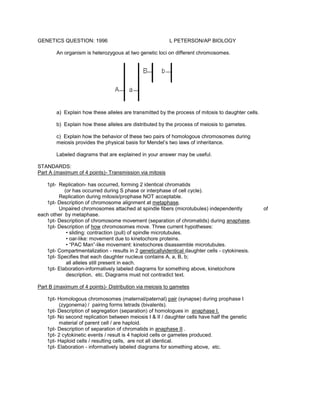
Genetics question
- 1. GENETICS QUESTION: 1996 L PETERSON/AP BIOLOGY An organism is heterozygous at two genetic loci on different chromosomes. a) Explain how these alleles are transmitted by the process of mitosis to daughter cells. b) Explain how these alleles are distributed by the process of meiosis to gametes. c) Explain how the behavior of these two pairs of homologous chromosomes during meiosis provides the physical basis for Mendel’s two laws of inheritance. Labeled diagrams that are explained in your answer may be useful. STANDARDS: Part A (maximum of 4 points)- Transmission via mitosis 1pt- Replication- has occurred, forming 2 identical chromatids (or has occurred during S phase or interphase of cell cycle). Replication during mitosis/prophase NOT acceptable. 1pt- Description of chromosome alignment at metaphase. Unpaired chromosomes attached at spindle fibers (microtubules) independently each other by metaphase. 1pt- Description of chromosome movement (separation of chromatids) during anaphase. 1pt- Description of how chromosomes move. Three current hypotheses: • sliding: contraction (pull) of spindle microtubules. • oar-like: movement due to kinetochore proteins. • “PAC Man”-like movement: kinetochores disassemble microtubules. 1pt- Compartmentalization - results in 2 geneticallyidentical daughter cells - cytokinesis. 1pt- Specifies that each daughter nucleus contains A, a, B, b; all alleles still present in each. 1pt- Elaboration-informatively labeled diagrams for something above, kinetochore description, etc. Diagrams must not contradict text. Part B (maximum of 4 points)- Distribution via meiosis to gametes 1pt- Homologous chromosomes (maternal/paternal) pair (synapse) during prophase I (zygonema) / pairing forms tetrads (bivalents). 1pt- Description of segregation (separation) of homologues in anaphase I. 1pt- No second replication between meiosis I & II / daughter cells have half the genetic material of parent cell / are haploid. 1pt- Description of separation of chromatids in anaphase II . 1pt- 2 cytokinetic events / result is 4 haploid cells or gametes produced. 1pt- Haploid cells / resulting cells, are not all identical. 1pt- Elaboration - informatively labeled diagrams for something above, etc. of
- 2. Part C (maximum of 4 points) - Relation of Mendel’s laws to events in mitosis/meiosis 1pt- Correct statement of law of segregation or results of segregation (“A” separates from “a”) during gamete formation. Paired elements separate randomly so each gamete receives one or other (paternal or maternal). 1pt- Segregation is due to separation of homologues during anaphase I. 1pt- Correct statement of independent assortment: during gamete formation, segregating pairs act independently of one another / AB, Ab, aB, ab. 1pt- Independent assortment is due to random alignment of tetrads (homologous pairs) during metaphase I (result is as likely to be AB as Ab...etc.). 1pt- Elaboration • Linked alleles do not show independent assortment (exception to Mendel’s law). • Other exceptions to Mendeliantransmission : including nondisjunction etc.